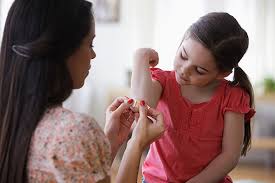Outdoor adventures, household chores, and even simple cooking mishaps can lead to minor injuries like cuts and scrapes. While these wounds may seem insignificant, proper care is crucial to ensure fast healing and prevent infections. Understanding the right steps can make all the difference in managing these minor injuries effectively.
In this comprehensive guide, we’ll explore the best practices for treating cuts and scrapes at home. With insights from medical experts, we’ll provide detailed instructions to ensure your injuries heal properly.

Why Proper Wound Care is Important
Even minor cuts and scrapes can become problematic if not handled correctly. Bacteria can easily enter through broken skin, leading to infections that may require medical intervention. By following proper hygiene, applying the right treatments, and monitoring the healing process, you can reduce the risk of complications.
Step 1: Maintain Proper Hygiene
The first and most crucial step in treating a cut or scrape is ensuring your hands are clean. This helps prevent introducing additional bacteria to the wound.
How to Clean Your Hands Before Treating a Wound
- Wash your hands thoroughly with mild soap and warm water for at least 20 seconds.
- Dry your hands with a clean towel or let them air dry.
- If soap and water are unavailable, use an alcohol-based hand sanitizer with at least 60% alcohol content.
Cleaning the Wound Itself
- Rinse the wound with sterile saline solution or a wound wash to remove dirt and debris.
- Avoid using harsh substances like hydrogen peroxide, rubbing alcohol, betadine, or witch hazel unless the wound is contaminated with dirt or bacteria.
- Gently pat the area dry with a clean cloth or sterile gauze.
Step 2: Control the Bleeding
If the cut or scrape is actively bleeding, you should address this immediately to prevent excessive blood loss.
Steps to Control Bleeding
- Apply gentle but firm pressure directly to the wound with a clean cloth, gauze, or sterile bandage.
- Maintain pressure for at least five minutes or until the bleeding stops.
- Elevate the injured area above heart level if possible to slow the bleeding.
Important: If bleeding continues after five minutes of steady pressure, seek medical attention immediately.
Step 3: Aid the Healing Process
Keeping the wound moist is vital to promoting faster healing and reducing the risk of scabbing or scarring.
How to Keep a Wound Moist
- Apply a thin layer of antibiotic ointment like Neosporin or Bacitracin to the affected area.
- Alternatively, petroleum jelly can effectively maintain moisture without irritation.
- Reapply the ointment daily or as needed to ensure the wound remains hydrated.
Why Moisture Matters
Dry wounds are prone to scabbing, which can slow the healing process and may result in scarring. Keeping the wound moist prevents painful scabs and promotes smoother recovery.
Step 4: Cover with a Sterile Bandage
Protecting the wound from dirt, bacteria, and irritation is crucial for proper healing.
How to Apply a Bandage Correctly
- Choose a bandage that fully covers the wound with some extra space on all sides.
- Ensure the adhesive edges stick securely without touching the wound itself.
- Change the bandage daily or whenever it becomes wet or dirty.
Step 5: Monitor for Signs of Infection
Even minor wounds can become infected if not properly cared for. Keep an eye out for symptoms that may require medical attention.
Signs of Infection to Watch For
- Redness spreading from the wound
- Swelling or warmth around the injury
- Persistent pain or tenderness
- Pus or unusual discharge
- Fever or chills accompanying the injury
If you notice any of these signs, consult your healthcare provider promptly.
When to Seek Medical Help
While most minor cuts and scrapes can be managed at home, certain situations require professional care. Seek medical attention if:
- The wound won’t stop bleeding after five minutes of consistent pressure.
- The cut is deeper than 1/4 inch or longer than 3/4 inch.
- The wound exposes fat, muscle, or bone.
- There is an embedded object in the wound.
- The injury was caused by a rusty or contaminated object.
Preventing Cuts and Scrapes in Everyday Life
While accidents are sometimes unavoidable, certain precautions can minimize the risk of injuries.
Safety Tips for Injury Prevention
- Wear protective gloves when gardening, handling tools, or cleaning.
- Keep knives sharp and use proper cutting techniques to prevent kitchen injuries.
- Use caution during outdoor activities, especially on rocky or uneven surfaces.
- Maintain a clean and organized living space to prevent trips and falls.
FAQs:
1. What should I do if my cut keeps bleeding?
If your cut continues to bleed after five minutes of consistent pressure, seek medical attention immediately. Applying pressure with clean gauze and elevating the injury can help slow the bleeding in the meantime.
2. Can I use hydrogen peroxide to clean my wound?
While hydrogen peroxide is often used as a disinfectant, it can damage healthy tissue and delay healing. It’s best to rinse the wound with sterile saline or clean water unless the injury is contaminated.
3. How often should I change my bandage?
Change your bandage daily or whenever it becomes dirty or wet. Keeping the wound clean and covered promotes faster healing and reduces infection risk.
4. Is it necessary to apply antibiotic ointment to every cut?
While antibiotic ointments like Neosporin can help prevent infection, clean wounds that are properly dressed can often heal well without them. However, applying a thin layer can provide added protection.
5. How can I prevent scarring from a cut or scrape?
Keeping the wound moist with petroleum jelly or antibiotic ointment helps reduce scabbing, which in turn minimizes scarring. Avoid picking at scabs during the healing process.




